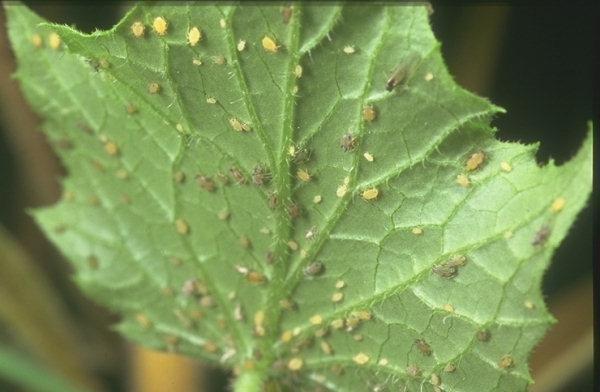What to do when aphids appear on cucumbers?
 Aphids reproduce at a very high rate. During the day, the colony is replenished with two hundred new insects. In nature, there are about 4000 species of aphids, several of them are common in the garden or in the garden:
Aphids reproduce at a very high rate. During the day, the colony is replenished with two hundred new insects. In nature, there are about 4000 species of aphids, several of them are common in the garden or in the garden:
- green aphid;
- black;
- cherry;
- goblet;
- rose-colored.
This insect pest affects all crops, except conifers, and especially aphids love to stalk on climbing plants. Cucumbers most often affects the black aphid. Many of these small insects climb onto young shoots of the cucumber whip and begin to suck the juice from the plant.
When aphids are affected, the leaves of the plant begin to curl and turn yellow, and then dry and fall off. The distance between adjacent leaves begins to decrease. The growth bud dries up and the lash stops developing. On the upper leaves, spots of sweet honeydew will be noticeable, which the aphid secretes in the process of life.
Read also the article: cucumber disease photo leaf treatment!
Removal of lesions
Aphids accumulate on the upper leaves of the plant, if there are a lot of insects, cut off young shoots and burn them. So you get rid of a large number of aphids, and new side shoots will come from the internode. After pruning the cucumber, chemical treatment can be carried out.
Aphids never settle on the lower leaves of the plant and its lignified branches, since this pest cannot bite through rough tissues. Therefore, surface treatments are sufficient to combat aphids.
Insecticide and bioactive treatments
For the fight against aphids, the drug "Aktara" is well suited. It is a contact insecticide that takes effect two hours after treatment. Aktara is a long-acting drug. Re-processing of the plant will need to be done in two weeks.
Insecticide "Aktara" is very toxic to bees, so treatments can be carried out only in the evening, when the bees have completed their evening flight.
In order to protect the insects of pollinators, instead of chemical insecticides, biological preparations, for example, "Fitoverm", can be used. This is also a long-acting insecticide. The drug acts on the intestines of the pest. After two hours of action, the aphid stops feeding, and after another three hours it dies.
Fitoverm is absolutely safe for bees and other pollinating insects, so treatment with a biological preparation can be carried out at any time of the day. Do not process the plant at noon, otherwise Fitoverm will quickly evaporate.
thank